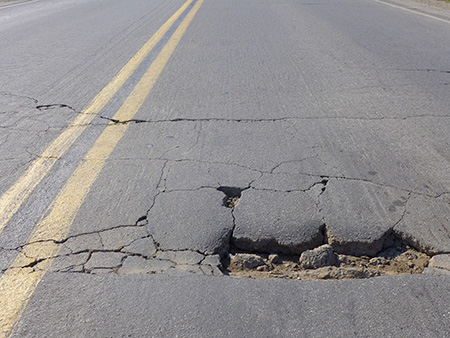It’s that wonderful time of year when our roads show widespread damage after the winter – as we navigate crumbling pavement and try to avoid potholes during our daily commutes.
Pothole craters are formed during winter’s freeze-thaw cycles when water from rain, melted ice and snow seeps into cracks and crevices in the asphalt, then expand into ice when the sub-zero temperatures move in.
- A Spring Guide to Preventative Maintenance
- Leaks, vibrations and squealing: signs your vehicle needs maintenance
It’s important to know what to do when you come upon a pothole and don’t have much time to react. You should also know about the types of damage these craters cause, from steering to tire damage.
Give yourself pothole padding
Properly inflating your tires will give you better odds of protecting against damage. Keep your tires to the recommended PSI (pounds per square inch) levels. Too much air or not enough could lead to problems when running into a hole in the pavement. Having properly inflated tires will also help you slow down when you can’t avoid a pothole.

Jamming the brakes won’t necessarily help either. Try to slow down, but hitting the brakes too hard can actually cause more damage. At slower speeds, your tire may drop right into the hole and still cause significant damage.
Steering clear of danger
Brace for impact and hold that steering wheel steady to avoid any sudden turning. Quickly swerving to avoid the pothole could put you and others at risk. A sudden turn while going too fast may put you into oncoming traffic, creating a much more dangerous collision.

Slamming into a massive pothole at the wrong angle can cause significant damage to your wheel alignment or suspension and can lead to steering problems. The experts say it’s best to slow down and stay straight.
Type of damage
After bashing into a pothole, you should notice quite quickly if you suffered any damage. If your wheel alignment is out, you’ll feel your steering wheel pulling to one side. If you don’t notice the pull, you may also see an uneven wearing of your tires over time.
Fluid leaks could indicate you suffered damage to your undercarriage, while a noisy exhaust system could mean you have a puncture. Damage to your suspension could lead to a host of other problems, possibly affecting many other parts, including shocks, struts, ball joints and tie rods.
Other tips to avoid potholes
If it’s been raining, avoid puddles on the roadway. You could find yourself in a deep, hidden pothole. You should also always report any dangerous road damage to your municipality. They deal with these pesky issues every year and remember: a squeaky wheel gets oil.
Looking for that part specific to your GM vehicle? Come check out our massive warehouse online.

Leave a Reply